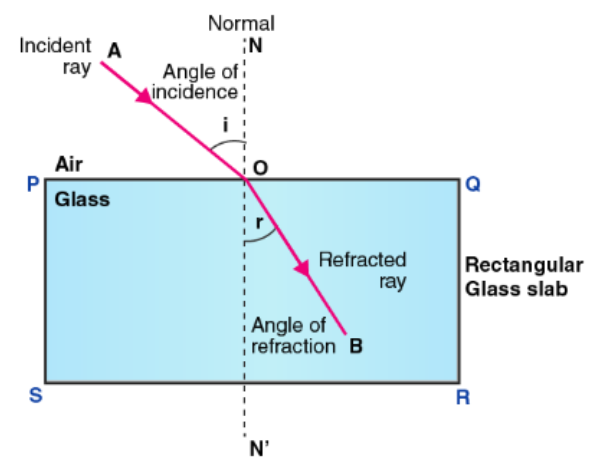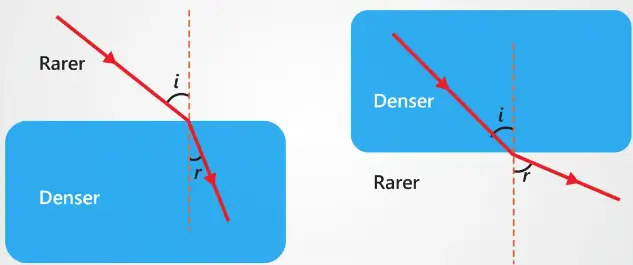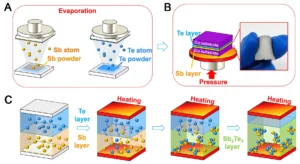Light, an enigmatic phenomenon, exhibits fascinating behaviours when it interacts with different mediums. One of the most captivating of these behaviours is refraction. Refraction is the bending of light as it passes from one medium to another, leading to a myriad of optical phenomena. Understanding the intricacies of refraction unveils the secrets behind the bending of light rays, crucial in numerous fields ranging from optics to atmospheric science.

Definition of Refraction:
Refraction, a fundamental concept in optics, refers to the bending of light rays as they transition from one transparent medium to another. This deviation occurs due to the change in speed experienced by light when traveling through materials of varying optical densities. Refraction is commonly observed when light passes through substances like air, water, glass, or even the Earth’s atmosphere.
Types of Refraction:

- Regular Refraction: Regular or normal refraction occurs when light passes from one medium to another with a uniform density gradient. In such cases, the light bends predictably, following Snell’s Law.
- Anomalous Refraction: Anomalous refraction occurs when light passes through a medium with a non-uniform density gradient. This results in unpredictable bending of light rays, often leading to distorted images or unusual optical effects.
Laws of Refraction:
Understanding the behaviour of light during refraction is encapsulated by two fundamental laws:
1. Snell’s Law: Named after the Dutch mathematician Willebrord Snellius, Snell’s Law quantitatively describes the relationship between the angles of incidence and refraction. It states that the ratio of the sine of the angle of incidence to the sine of the angle of refraction is equal to the ratio of the velocities of light in the two respective mediums. Mathematically, it can be expressed as:
Sinθ1 / Sinθ2 = V1 / V2
Where θ2 and θ2 are the angles of incidence and refraction, V1 and V2 are the velocities of light in the two mediums, respectively.
2. Snell-Descartes Law: This law is a special case of Snell’s Law when light passes from a denser medium to a less dense one. It asserts that the angle of incidence is always greater than the angle of refraction.
Notable Phenomena and Applications:
- Twinkling of Stars in a Clear Sky: As starlight enters the Earth’s atmosphere, it encounters variations in air density and temperature. These atmospheric layers cause the light rays to refract, leading to the twinkling effect observed from the ground.
- Perception of Shallow Depth in a Pool of Water: When light travels from air into water, it bends due to the change in optical density between the two mediums. This bending makes objects submerged in the water appear shallower than they actually are, altering our perception of depth.
- Formation of Rainbows in the Sky: Rainbows are a stunning natural phenomenon resulting from the refraction, dispersion, and reflection of sunlight by water droplets suspended in the atmosphere. As light passes through these droplets, it undergoes multiple refractions, separating into its constituent colours and creating the iconic arc of colours in the sky.
- Corrective Eyewear (Glasses or Contacts): Glasses and contact lenses utilise the principles of refraction to correct vision problems. By altering the path of light as it enters the eye, these optical devices compensate for refractive errors such as nearsightedness or farsightedness, enabling clearer vision.
- Refraction in Human Eyes: The human eye contains a lens that refracts light to focus images onto the retina, facilitating vision. This natural process of refraction enables us to perceive the world around us with clarity and detail.
- Prism: Prisms are optical elements with a triangular shape that can refract and disperse light. They are commonly used in spectroscopy, photography, and optical instruments to separate white light into its component colours or to redirect light beams.
- Distortion in a Pickle Jar: When viewing objects through the curved surface of a glass jar filled with liquid, such as a pickle jar, light undergoes refraction. This can cause the objects to appear distorted or magnified due to the bending of light rays as they pass through the curved glass.
- Formation of Halo Phenomena in Ice Crystals: Halo phenomena, such as circular halos around the sun or moon, occur when sunlight or moonlight is refracted by hexagonal ice crystals in the atmosphere. The refraction of light through these crystals produces optical effects, creating luminous rings or arcs in the sky.
- Refraction in Glass: Glass is a transparent material that exhibits significant refraction properties. When light passes from air into glass or vice versa, it bends due to the difference in optical density between the two mediums, allowing for the transmission of light through glass windows, lenses, and other optical components.
- Functioning of Microscopes or Telescopes: Microscopes and telescopes rely on lenses and mirrors to manipulate the path of light through refraction and reflection. By controlling the refraction of light rays, these optical instruments magnify and resolve images, enabling detailed observation of microscopic or distant objects.
- Mirage: Mirages are optical illusions caused by atmospheric refraction, commonly observed in deserts or hot surfaces. The bending of light rays due to temperature gradients in the air creates the illusion of water or objects appearing displaced from their actual positions.
Conclusion:
Refraction of light is a captivating phenomenon that underpins various optical phenomena and technological advancements. From the bending of light in lenses to the formation of mesmerising mirages, understanding the principles and laws of refraction unlocks a world of optical wonders. As researchers delve deeper into the mysteries of light, the applications of refraction continue to expand, enriching our understanding of the universe and enhancing technological innovations.




